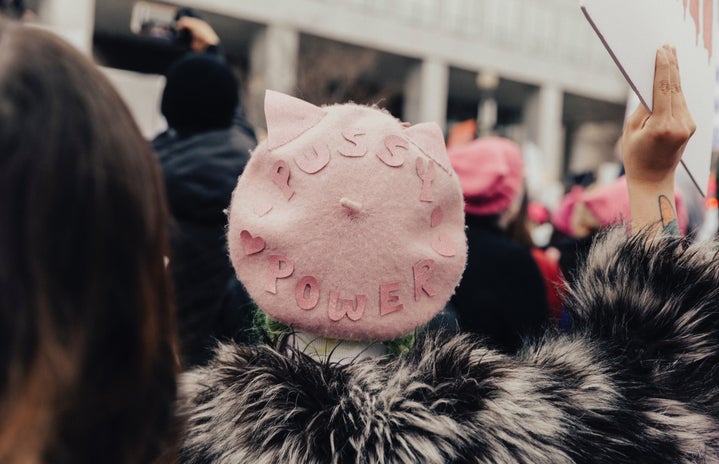I’m tapping my foot on the floor. It’s been at least five minutes—maybe ten—and the door remains closed, with red letters reading “OCCUPIED” above the door handle. I cross my arms, trying not to look too impatient, trying not to take up too much space. Trying to be patient.
A girl comes out of the women’s bathroom next door and grimaces. She came in while I was waiting, and she’s not the first to leave while I’m still standing here. “I’d recommend knocking,” she offers, walking away.
I laugh awkwardly, nodding, and stepping forward to tap on the door. As I do, however, the door swings open. I try not to look too frustrated at the person stepping out, and step inside.
When I get back to my jacket and backpack in the cafeteria, two floors above, I check my phone. I have spent nearly fifteen minutes trying to use the bathroom.
As a nonbinary student, if I need to use a public restroom at the New School University Center, my journey is a bit different from that of binary individuals. Instead of just going into the women’s or men’s bathrooms, conveniently located down the hall from the cafeteria, I have to leave my things on a table because there’s no hook on the door of the nearest gender-neutral bathroom. I have to descend two flights of stairs, walk past the elevators, and wait usually between five and ten minutes for the bathroom to open up, since it’s a single-user bathroom. Sometimes I’m lucky, and whoever was in it previously was using it properly; sometimes I’m not, and I have to try not to inhale the weed fumes as I do my best just to go about my day.
The New School likes to pride itself on its progressive stance when it comes to transgender students. Professors often ask for pronouns at the beginning of classes, and there is a Google form to change one’s name within the school’s system even if one hasn’t legally changed their name yet. And when the White House memo that suggested that transgender people might be erased from Title IX leaked last fall, President David Van Zandt sent out an email to the school assuring the student population that transgender people would not be erased at The New School.
But this progressive stance covers up a significant amount of ways in which transgender people are regularly invalidated or disrespected by The New School. I’ve had my pronouns asked by most of my professors, but both classmates and professors alike have ignored, forgotten, or even refused to use them on several occasions. The Google form for changing one’s name, for whatever reason, does not apply to administrative emails. Whenever I get an email from my college’s dean, or an offer to take a survey, or anything else automatic, I am addressed by my deadname. And emails of assurance fall somewhat flat when one is erased—with the best of intentions—by one’s own school.
Which brings us to bathrooms.
I am aware that, as conditions for transgender people go, I am luckier than many to attend a school that even attempts to make things easier for its transgender students. At the same time, however, that makes it all the more infuriating—with everything that The New School is founded on, why hasn’t it fixed these problems? Why do we fall through cracks that our school claims have been patched up? Why, for the love of God, do I have to carve twenty minutes out of my day just to go to the bathroom?
Perhaps something that they miss is that gender-neutral bathrooms do not have to be single-user. In addition to dramatically cutting the wait time, stalls would be much more likely to have hooks on the doors—an important installation for students, since most of us have backpacks and jackets, especially in the winter. None of the gender-neutral bathrooms I have been in at The New School have any place to put things one is carrying, forcing people to either find someone to watch their things or leave them unattended.
Besides all this, the gender-neutral bathrooms at The New School are often also the bathrooms with changing rooms, or that offer extra room for people in wheelchairs. I am an able-bodied nonbinary person with no need for a changing table. I’d be happy to use a stall if it were offered to me. Instead, my discomfort with binary bathrooms forces me to take up space I don’t need, and that I would much rather leave to people with children or people who need extra space.
It’s an important point to note that I am not forbidden from using the binary restrooms. But I, personally, feel uncomfortable with doing so. I’m not a woman, so I don’t want to use the women’s room unless I can help it, but I’m not a man, either. I am nonbinary, and I’m proud of my identity. I just want to be able to have the same ease at finding a bathroom in The New School as binary people do.
I would like to believe that the intentions of The New School are to make things easier for transgender students. But regardless of their intent, their impact is one that creates issues for transgender students that are not being addressed. There are promises The New School needs to keep—if they say that a student can go by one name, that should be the name they are addressed by in all correspondence. If they say that a student’s pronouns will be asked and respected by professors, that needs to be upheld.
And if they claim to have a progressive policy on bathrooms in The New School, it might be good if they started acting like it.
[All images sourced from Unsplash]



